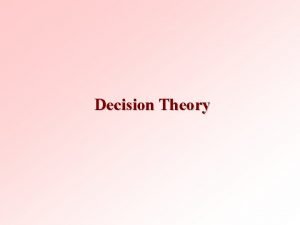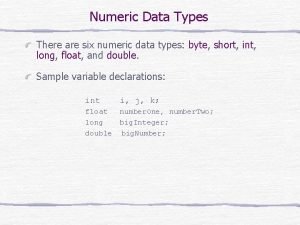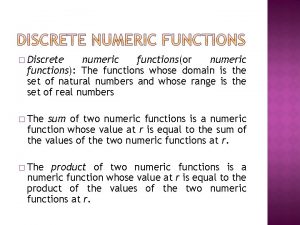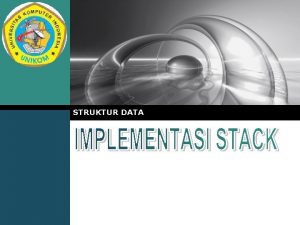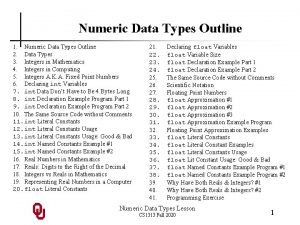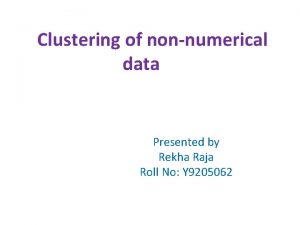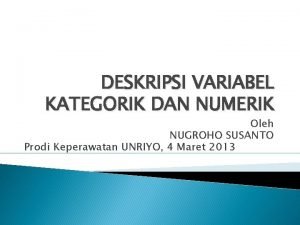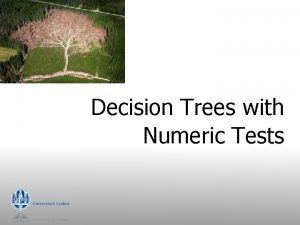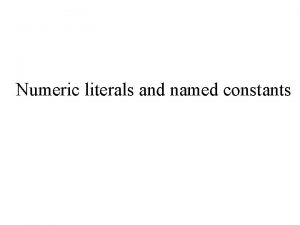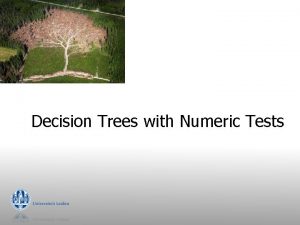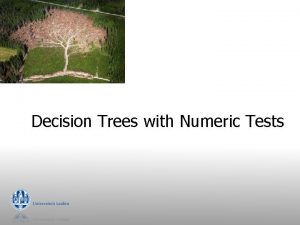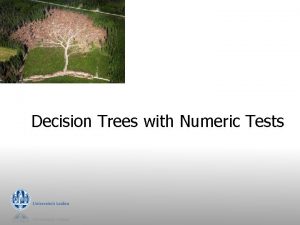Decision Trees with Numeric Tests Industrialstrength algorithms For


















- Slides: 18

Decision Trees with Numeric Tests

Industrial-strength algorithms § § For an algorithm to be useful in a wide range of realworld applications it must: § Permit numeric attributes § Allow missing values § Be robust in the presence of noise Basic schemes need to be extended to fulfill these requirements

C 4. 5 History § ID 3, CHAID – 1960 s § C 4. 5 innovations (Quinlan): § permit numeric attributes § deal sensibly with missing values § pruning to deal with for noisy data § C 4. 5 - one of best-known and most widely-used learning algorithms § Last research version: C 4. 8, implemented in Weka as J 4. 8 (Java) § Commercial successor: C 5. 0 (available from Rulequest)

Numeric attributes § Standard method: binary splits § E. g. temp < 45 § Unlike nominal attributes, every attribute has many possible split points § Solution is straightforward extension: § § Evaluate info gain (or other measure) for every possible split point of attribute § Choose “best” split point § Info gain for best split point is info gain for attribute Computationally more demanding

Example § Split on temperature attribute: 64 65 68 69 Yes No Yes 70 71 72 72 75 Yes No No Yes 75 80 81 83 Yes No temperature 71. 5: yes/4, no/2 temperature 71. 5: yes/5, no/3 § E. g. § Info([4, 2], [5, 3]) = 6/14 info([4, 2]) + 8/14 info([5, 3]) = 0. 939 bits § Place split points halfway between values § Can evaluate all split points in one pass! 85

Example Split on temperature attribute: info. Gain § 0 64 65 68 69 Yes No Yes 70 71 72 72 75 Yes No No Yes 75 80 81 83 85 Yes No

Speeding up § Entropy only needs to be evaluated between points of different classes (Fayyad & Irani, 1992) value 64 class Yes 65 68 69 No Yes 70 71 72 72 75 Yes No No Yes 75 80 81 83 85 Yes No X Potential optimal breakpoints Breakpoints between values of the same class cannot be optimal

Missing as a separate value § Missing value denoted “? ” in C 4. 5 § Simple idea: treat missing as a separate value § Q: When is this not appropriate? § A: When values are missing due to different reasons § Example 1: gene expression could be missing when it is very high or very low § Example 2: field Is. Pregnant=missing for a male patient should be treated differently (no) than for a female patient of age 25 (unknown)

Missing values - advanced Split instances with missing values into pieces § § A piece going down a branch receives a weight proportional to the popularity of the branch § weights sum to 1 Info gain works with fractional instances § § use sums of weights instead of counts During classification, split the instance into pieces in the same way § Merge probability distribution using weights

Application: Computer Vision 1

Application: Computer Vision 2 feature extraction § § § color (RGB, hue, saturation) edge, orientation texture XY coordinates 3 D information

Application: Computer Vision 3 how grey? below horizon?

Application: Computer Vision 4 prediction

Application: Computer Vision 4 inverse perspective

Application: Computer Vision 5 inverse perspective path planning

Quiz 1 Q: If an attribute A has high info gain, does it always appear in a decision tree? A: No. If it is highly correlated with another attribute B, and info. Gain(B) > info. Gain(A), then B will appear in the tree, and further splitting on A will not be useful. B + - + + + A +

Quiz 2 Q: Can an attribute appear more than once in a decision tree? A: Yes. If a test is not at the root of the tree, it can appear in different branches. Q: And on a single path in the tree (from root to leaf)? A: Yes. Numeric attributes can appear more than once, but only with very different numeric conditions. + + + -- + A

Quiz 3 Q: If an attribute A has info. Gain(A)=0, can it ever appear in a decision tree? A: Yes. 1. All attributes may have zero info gain. 2. info gain often changes when splitting on another attribute. B - the XOR problem: + - - + + + - - + - A
 No decision snap decision responsible decision
No decision snap decision responsible decision Slidetodoc.com
Slidetodoc.com Ace different help iq tests but
Ace different help iq tests but Supply chain network design decisions
Supply chain network design decisions Criterion of realism formula
Criterion of realism formula Dfd chapter 5
Dfd chapter 5 Decision tree and decision table
Decision tree and decision table Sqlite numeric type
Sqlite numeric type Numeric data types in java
Numeric data types in java Bcd5311
Bcd5311 Discrete numeric function
Discrete numeric function Numerical notation
Numerical notation Numeric indicator
Numeric indicator Straight numeric filing
Straight numeric filing Numeric outline
Numeric outline Clustering non numeric data
Clustering non numeric data Contoh variabel kategorik dan numerik
Contoh variabel kategorik dan numerik Numerical expression
Numerical expression Advantages and disadvantages of output devices
Advantages and disadvantages of output devices




